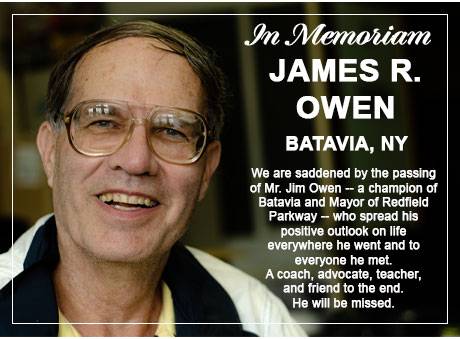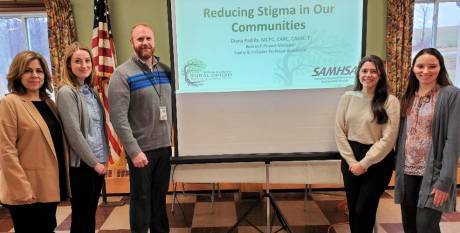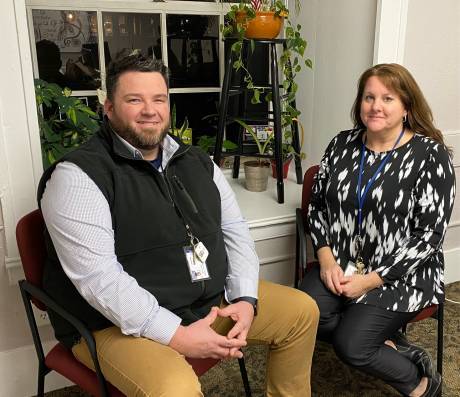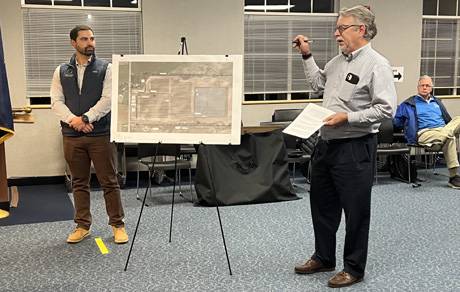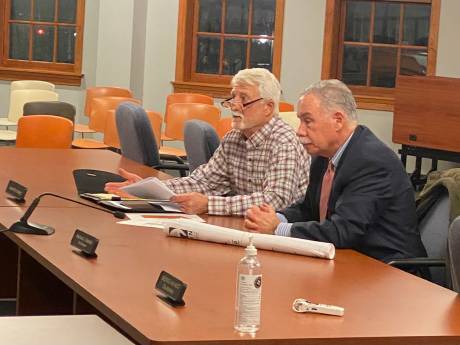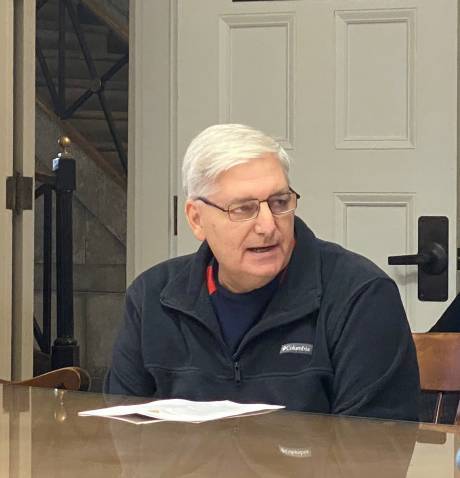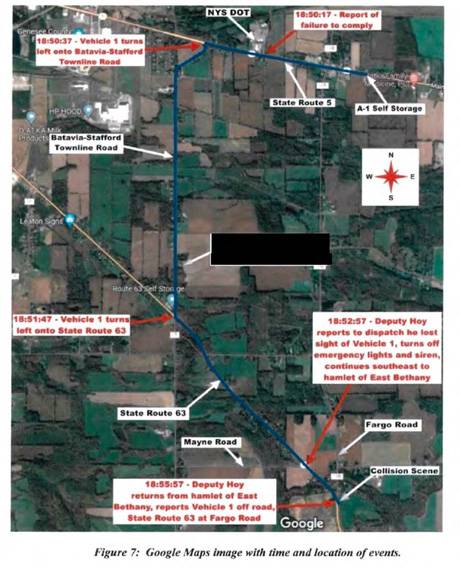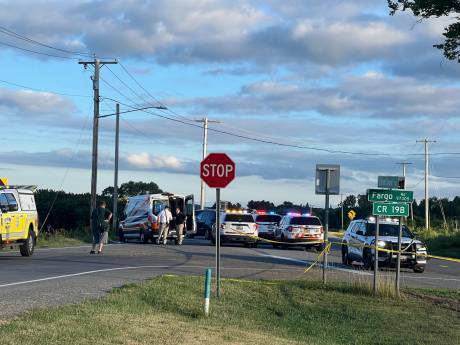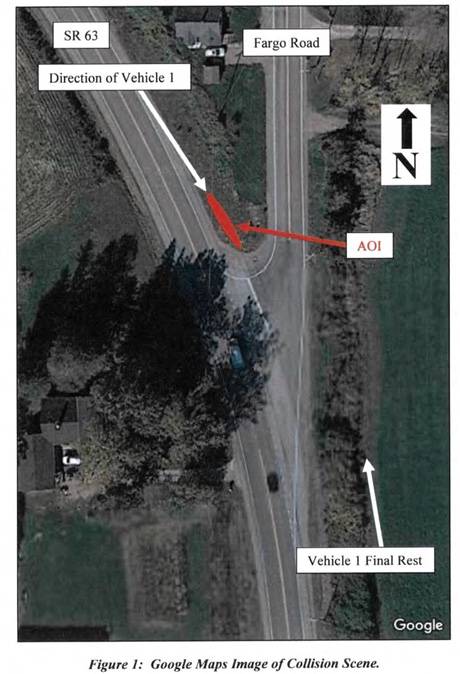A State Police investigation into a fatal motorcycle accident, following a high-speed pursuit by a sheriff's deputy in Batavia and Stafford, cleared the deputy of any fault in the incident, according to a report obtained by The Batavian through a Freedom of Information Law request.
Nicholas L. Keiffer, 26, of West Center Street, Medina, lost control of his 2001 Kawasaki Ninja on July 6 on Route 63 as he entered a curve in the roadway just north of Fargo Road after fleeing an attempted traffic stop by Deputy Zachary Hoy.
The state's Executive Law requires the Office of Attorney General (OAG) to open an investigation when a person's death may have been caused by a police officer. Based on findings by the State Police, the OAG informed District Attorney Kevin Finnell on Aug. 2 that the evidence indicated the OGA had no statutory authority to open a criminal investigation into the conduct of the deputy.
In other words, the OAG informed the county that there is no evidence of misconduct in the incident by the deputy.
Investigator Thomas K. Rzepecki, of the Troop A Collision Reconstruction Unit, completed an accident reconstruction report for the State Police, and he concluded that Keiffer was at fault in the accident.
"The primary contributing factor to this collision, as it relates to the analysis of the evidence, was the failure of the operator of Vehicle 1, Nicholas L. Keiffer, to remain within his appropriate lane of travel," he wrote in the report. "The high speed at which Mr. Keiffer entered the right-hand curve prior to the intersection contributed to his failure to keep right, and also to the severity of the injuries sustained in the collision. An additional factor to consider is Mr. Keiffer's failure to comply with Deputy Hoy's attempt to affect a traffic stop on SR 5."
He also states, "Roadway defects, environmental conditions, and vehicular defects have all been considered and ruled out as contributing to the cause of the collision."
Investigator Eric Daigler officially closed the investigation based on the findings on Dec. 22.
150 mph
The incident began shortly before 6:50 p.m. on July 6. Hoy was running radar in the parking lot of A-1 Self Storage, 5658 Main St, Stafford, when he observed a motorcycle passing another vehicle on westbound Route 5. The radar indicated the motorcycle was traveling at 150 mph.
Hoy entered the lane of traffic and activated his emergency lights.
The motorcycle initially pulled over as if stopping for the officer near the Department of Transportation facility at 5441 Main St., Stafford. As Hoy pulled in behind the motorcycle, the driver fled.
Radio transmissions acquired by Daigler from the Sheriff's Office, indicate that Hoy informed dispatchers at 6:50 p.m. that the motorcycle was fleeing. Hoy activated his lights and siren and began a pursuit.
The motorcycle turned left on Batavia-Stafford Townline Road.
Data, obtained by Daigler, recorded on the patrol vehicle's computer system, indicate the top speed of Hoy's vehicle while on Batavia-Stafford Townline Road was 104 mph.
A resident's Ring camera captured the motorcycle passing that location (the address is redacted in the report) at a high rate of speed and then recorded Hoy's vehicle passing with lights and sirens 18 seconds later.
Hoy observed the motorcycle turn left onto Route 63. Vehicle data indicate Hoy's vehicle turned left 20 seconds later. Hoy's top speed on Route 63 was 120 mph.
Near Route 63 and Mayne Road, at 6:52 p.m., Hoy informed dispatchers he had lost sight of the motorcycle and was discontinuing the pursuit.
He deactivated his lights and siren and slowed his speed, and continued southbound.
At 63 and Fargo, Hoy told Senior Investigator Brian Howard during an interview on July 11, that he spotted a small dust cloud along the roadway and thought perhaps the rider had crossed into the shoulder while negotiating the turn.
His speed at that intersection was 53 mph.
Hoy continued into the hamlet of East Bethany at 30 mph, where he turned around.
When he again reached 63 and Fargo at 6:55 p.m., with a northbound vantage point on the intersection, he spotted Keiffer's motorcycle on its side in a field behind a hedge row.
According to scanner traffic at the time of the incident, a person at the scene -- likely Hoy -- attempted CPR on Keiffer. Keiffer would later be pronounced dead at the scene by a county coroner.
Among the first Sheriff's Officer personnel on scene was Investigator Ryan Delong. He photographed the scene. Those photographers were later turned over to State Police. DeLong also told State Police that the NYS Office of the Attorney General was advised of the accident. Detectives from the OAG's Office of Special Investigations responded to the scene.
Soon after the accident, Sheriff William Sheron requested the State Police conduct the investigation because the incident involved one of his deputies.
Evidence
Rzepecki described the intersection in his report.
Route 63 contains a dip in the roadway followed by a right-hand curve with an uphill grade, according to the report. There is a yellow advisory sign about 500 feet ahead of the curve that recommends vehicles slow to 45 mph. The posted speed limit is 55 mph.
Evidence at the scene consisted of tire marks, furrows, an impacted signpost, vehicle debris, pavement scrapes and gouges, and disturbed vegetation.
Rzepecki stated that tire marks were found on the east shoulder of Route 63 and continued southeast across the shoulder into a grassy area north of the intersection, where it transitioned into a series of furrows. Investigators determined it was at that point that the motorcycle overturned and struck a signpost.
Vehicle debris and grass fanned out southeast of the impact point across Fargo Road and led to a series of pavement scrapes and gouges. There was vehicle fluid and tire marks within the northbound lane and east shoulder of Fargo Road and disturbed vegetation and vehicle debris that led to the location of the motorcycle.
Rzepecki wrote, "The observed evidence indicates that Vehicle 1 was traveling southeast on SR 63. It crossed the center line and exited the east shoulder of the roadway, overturned, struck a signpost, and became airborne across the southbound lane of Fargo Road. Vehicle 1 landed within the northbound lane and east shoulder of Fargo Road, continued southeast down an embankment, and came to an uncontrolled final rest in the field east of the roadway."
The driver was ejected and sustained fatal injuries, Rzepecki reported.
Hoy's patrol vehicle was undamaged, and Rzepecki said there was no evidence of contact between the patrol vehicle and the motorcycle.
Based on an investigator's calculations, the maximum speed a vehicle can negotiate the curve is 91 mph. Based on calculations using evidence at the scene, Keiffer's Kawasaki was traveling at between 87 and 92 mph just before it came to the curve. That calculation does not include the possibility of any breaking by Keiffer just prior to that point. At the point the bike became airborne, after it left the pavement, it was likely traveling at 77 mph, according to the report.
Daigler obtained Keiffer's mobile phone. Keiffer's mother signed a consent form allowing the State Police to search the phone. A forensic investigator later informed Daigler that all pertinent data from the phone was stored in the Google cloud. Daigler contacted Douglas Curella, the law clerk for County Court Judge Melissa Lightcap Cianfrini, about obtaining a warrant ordering Google to turn over the data. Curella later informed Daigler that Cianfrini would not sign a warrant "because no legal action is being taken by the State Police and the only individual who committed crimes related to the investigation is now deceased."
In addition to patrol vehicle data, video footage, physical evidence at the scene, and recorded and timestamped radio transmissions, investigators interviewed 19 witnesses.
Among those witnesses was the mother of Keiffer's girlfriend.
Keiffer was reportedly living at their house at the time, and he and his girlfriend's mother were speaking outside at about 6:15 p.m. when they observed a motorcycle pass their location. Keiffer reportedly observed that the motorcycle was a 'nice bike' and informed the mother he was going to go for a ride.
Top Illustration: Screenshot of an illustration in the State Police report. For a higher-resolution version, click here.
Accident scene photo from July 6 by Howard Owens
Screenshot of illustration in State Police report.



